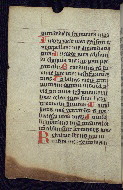Home > Digitized Walters Manuscripts
This document is a tranformation of a TEI P5 XML manuscript description incorporating images. If you have trouble reading special or non-Latin characters on this page, please make sure you have appropriate Unicode fonts installed and an up-to-date web browser.
Walters Ms. W.16, Fragmentary Psalter
Browse images (Browse images in a new window) | TEI in XML format
W.16
Fragmentary Psalter
This fragmentary psalter was made in the thirteenth century in southern Germany. Several quires are missing from the beginning and end of the book, resulting in the loss of a large portion of the psalms, as well as most of the Office of the Dead. The manuscript itself has no decoration outside of slightly enlarged red initials. However, an ornate gilded and jewel-encrusted cover was added to the original wood boards in the late nineteenth or early twentieth century, and it is a product of that era. The only original medieval elements within this pastiche are the thirteenth-century enamels, which are of Cologne origin.
13th century CE
Wurzburg (?), southern Germany
Book
Devotional
The primary language in this manuscript is Latin.
Parchment
Parchment is in poor condition, with top and bottom edges severely damaged by water and/or fire
Foliation: 61
Several quires cut out at beginning and end of book; current condition reflected in modern pencil foliation in upper right corners of rectos, with occasional second number that has been struck out
Formula: 1(8), 2(6), 3(8,-6), 4(8,-4), 5(8,-6), 6-8(8), 9(2,-2), 10(2,-2)
Catchwords: None
Signatures: None
Comments: Quire 2 composed of a bifolium with four single sheets sewn in; quires 9 and 10 are detached, non-continuous folios; quires begin on fols. 1(1), 9(2), 15(3), 22(4), 29(5), 36(6), 44(7), 52(8), 60(9), and 61(10); stubs from two quires of eight remain at the beginning, and from two quires of eight and one quire of six at the end
14.7 cm wide by 20.9 cm high
8.0 cm wide by 13.2 cm high
- Columns: 1
- Ruled lines: 18
- Ruled in dark brown ink
- Title: Psalter
- Text note: Text incomplete due to large groups of pages missing from beginning and end, and several others missing throughout
- Hand note: Formal Gothic bookhand; two sizes used according to liturgical function; two scribes evident; mainly second scribe who varies size of script (e.g. fols. 60r-61v: Office of the Dead)
- Decoration note: Enlarged red initials (2-7 lines) begin each psalm; smaller red initials (1 line) at beginning of each line; rubrics in red; text in black ink
- Title: Psalms
- Incipit: ...[taber]naculis iustorum dextera Domini fecit virtutem
- Text note: Text begins imperfectly at the very end of Psalm 117:15; stubs visible between fols. 13 and 14, 19 and 20, 24 and 25, 33 and 34, however no text is missing
- Title: Canticles
- Incipit: Confitebor tibi
- Title: Litany and collects
- Incipit: Kyrie eleyson
- Text note: Notable in the litany: SS. Burchardus, Udalricus, and Pinnosa
- Title: Office of the Dead
- Rubric: Vigilia.
- Incipit: Verba mea auribus percipe
- Text note: Fragmentary
- Title: Collects
- Rubric: In depositione defunctorum oratio.
- Incipit: Quesumus domine
- Text note: Text ends imperfectly
The binding is not original.
Wood boards are original; ornate gilded metal cover is a nineteenth- or early twentieth-century pastiche, with Christ enthroned surrounded by Evangelists in medallions; a letter from Léon Gruel in states that he thought it was authentic; ca. 1200 German champlevé enamel panels embedded in cover are authentic (one was removed due to condition in 1955); nineteenth-century red velvet on lower board
Created in southern Germany, possibly Wurzburg, in the thirteenth century
Léon Gruel, Paris, late nineteenth or early twentieth century
Henry Walters, Baltimore, purchased from Léon Gruel before 1931
Walters Art Museum, 1931, by Henry Walters' bequest
De Ricci, Seymour. Census of Medieval and Renaissance Manuscripts in the United States and Canada. Vol. 1. New York: H. W. Wilson Company, 1935, p. 771, cat. no. 89.
Catalogers: Dutschke, Consuelo; Herbert, Lynley; Noel, William; Sciacca, Christine; Valle, Chiara
Editor: Herbert, Lynley
Copy editor: Joyal, Stephanie
Conservators: Owen, Linda; Quandt, Abigail
Contributors: Bockrath, Diane; Davis, Lisa Fagin; Emery, Doug; Klemm, Elizabeth; Tabritha, Ariel; Toth, Michael B.
The Walters Art Museum
Licensed for use under Creative Commons Attribution-NonCommercial-ShareAlike 3.0 Unported Access Rights, http://creativecommons.org/licenses/by-nc-sa/3.0/legalcode. It is requested that copies of any published articles based on the information in this data set be sent to the curator of manuscripts, The Walters Art Museum, 600 North Charles Street, Baltimore MD 21201.

